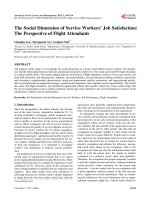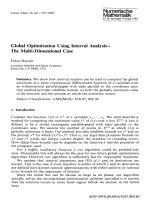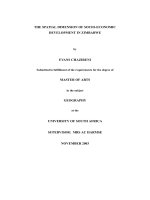E-business – the organizational dimension
Bạn đang xem bản rút gọn của tài liệu. Xem và tải ngay bản đầy đủ của tài liệu tại đây (82.59 KB, 8 trang )
THREE E
-
BUSINESS
–
THE ORGANIZATIONAL DIMENSION
23
THREE
E-business – the organizational
dimension
To note that information technology is having an impact on organi-
zations is on a par with saying that Madonna seems to notch up the
occasional column inch in the newspapers. Despite those gainsay-
ers who have noted the demise of innumerable dot.coms with a certain
schadenfreude, the fact is that the impact of the internet and allied
technologies has already been significant and can only increase over
the coming years.
When it comes to assessing that impact, however, we hit a small
problem. There’s a well known aphorism that if you want to find out
about water, then don’t go asking a fish. Just as water quickly becomes
unremarkable when you spend all your time swimming in it, so we
humans have a remarkable capacity for accommodating technolog-
ical change with barely a second glance.
And yet all the major technologies have significant, if subtle, impact
on the way we work and live. Take the light bulb. Before the inven-
tion of the electric light by Thomas Edison, people used to sleep an
average of ten hours a night. These days, we sleep on average for
just over seven hours, with a third of people getting by on less than
six hours. More recently, the mobile phone has gone from being the
stuff of futuristic science programmes to commonplace in a handful
of years.
In terms of extent and speed of impact, though, the internet has
outpaced all of the great disruptive technologies of the 20th century
– electricity, the telephone, the motor car, and so on. Amid everything
else it is doing, the internet is re-inventing the nature of work.
GURUS ON E
-
BUSINESS
24
There are plenty of people writing about the impact of technology at
a high level. There is no doubt that technology has enabled the creation
of a global market place. Books and articles abound on ‘the death of
distance’, ‘the conquest of location’, the irrelevance of size, the
subjugation of time, and so on.
The internet and organizations
In terms of our day-to-day experience, here are just some of the ways
in which the internet is changing the fabric of our working lives:
Most internet businesses are built on greenfield sites
There are very few Chief Executives of more traditional, bricks-and-
mortar companies who would admit to being totally happy with the
structure, shape and size of their organizations.
Also, it seems that most CEOs are pretty unenamoured of the people
that work for them and alongside them. A survey carried out a few
years ago by the Institute of Directors and Development Dimensions
International asked senior directors what percentage of their employ-
ees they would re-hire if they could change all their employees
overnight. Half said they would re-hire between 0% and 40%. Only
7%, moreover, expressed confidence in the leadership capabilities of
their peers within their organizations.
Internet start-ups do not face these problems, at least not in the early
days. The organization is consciously designed and the people
involved are handpicked. They do not, in short, suffer from what a
CEO chum of mine calls ‘inherited incompetence’.
THREE E
-
BUSINESS
–
THE ORGANIZATIONAL DIMENSION
25
Hierarchy
A traditional organization is structured around two key concepts –
the breakdown and management of goals and tasks through the use
of hierarchy and stable employee relationships over prolonged
periods of time. In internet organizations, structures are more flexi-
ble and dynamic. Hierarchy has not vanished but it has been
augmented by distributed lattices of interconnections.
In an interview on The Motley Fool Radio Show in April 2000, CEO
Tim Koogle, described the set-up at Yahoo!: “It’s not hierarchical. We
do have a structure in the company because you need a structure to
have some order on things, but it’s a pretty flat organization”.
For well-established organizations, Shoshana Zuboff of the Harvard
Business School believes that a rigid hierarchy gets in the way of
making best use of technology. She writes: ‘The successful reinven-
tion of the firm consistent with the demands of an information economy
will continue to be tragically limited as long as the principal features
of modern work are preserved. Unlocking the promise of an infor-
mation economy now depends on dismantling the very same
managerial hierarchy that once brought greatness’.
Decision making
In an e-business, as with more traditional businesses, the leadership
team typically make all the big strategic decisions about what the
company is going to do. The difference is that decision-making in e-
businesses is often a more collaborative process. At Yahoo! for example,
Tim Koogle has described how working in adjoining cubicles affects
the leadership team’s approach to decision-making: ‘During a normal
day, you’ll find us hollering back and forth across the wall, bouncing
around inside the cubes, grabbing each and going off into a little confer-
ence room’.
Another facet of decision making in internet start-ups is that compa-
nies grow too fast to be managed closely from the centre. Decisions,
GURUS ON E
-
BUSINESS
26
once taken centrally, are rapidly devolved to those working in the busi-
ness to determine the method and manner of implementation.
Internal communication
This is not a problem for e-businesses in the early days when the organ-
ization consists of a small group of highly motivated people who spend
a lot of time in each other’s company, and who therefore automati-
cally keep themselves and each other in the picture. However,
business growth needs to be fuelled by new blood. By definition these
are people who were not part of the original set-up and therefore
processes and systems need to be introduced to ensure that every-
body is kept informed – it no longer happens naturally.
For internet businesses, the speed of growth means that the need for
more formalized communication systems can kick in very quickly. The
ill-fated boo.com, for example, went from 12 or so people to over 400
in less than a year.
The working day now lasts 24 hours
Information technology has the capacity not only to change where
knowledge and power reside in the organization; it also changes time.
The ‘working day’ has less meaning in a global village where commu-
nication via electronic mail, voice mail, and facsimile transmissions
can be sent or received at any time of day or night. Paradoxically, as
the working day has expanded, so time has contracted. Companies
compete on speed, using effective co-ordination of resources to reduce
the time needed to develop new products, deliver orders or react to
customer requests.
Growth has been de-coupled from employment
Particularly during the 1980s, it became more and more apparent that
the real bottom line of technology was that it made jobs go away. It
didn’t happen all at once. But, starting in the manufacturing indus-
THREE E
-
BUSINESS
–
THE ORGANIZATIONAL DIMENSION
27
tries and then moving into white-collar work, every day more work
was either being automated or relocated to other parts of the world
with lower labour costs.
Not enough good people to go around
For most e-businesses, the factor that limits or enables rapid growth
is their capacity to recruit and retain good people. Finding the right
people to sustain rapid growth is problematic for any business at any
stage of its lifecycle. For an unproven e-business start-up, particu-
larly now that the internet economy has lost its luster, it can be virtually
impossible. Significantly, most of the consultancy fees paid by e-busi-
ness start-ups to date have gone to specialist recruitment companies.
The workplace becomes transparent
Shoshana Zuboff argues in an article for Scientific American that infor-
mation technologies transform work at every organizational level by
potentially giving all employees a comprehensive, or near compre-
hensive, view of the entire business. These technologies surrender
knowledge to anyone with the requisite skills. This contrasts with earlier
generations of technological advance where the primary impact of
new machines was to decrease the complexity of tasks.
Technology also facilitates the open sharing of know-how within a
company. By and large, e-businesses have a better track record at
knowledge management. Many traditional companies retain a ‘knowl-
edge is power’ mentality, and even those that consciously set out to
create a knowledge sharing environment can fall foul of knowledge-
hoarding by suspicious business units or individuals fearful of
becoming dispensable.
The rise of the virtual organization
Virtual organizations are formed by a cluster of interested parties to
achieve a specific aim – perhaps to bring a specific product or idea









